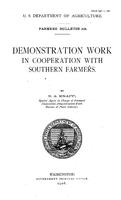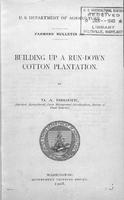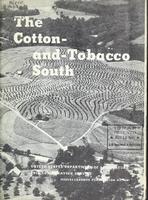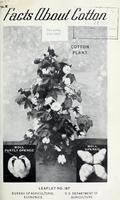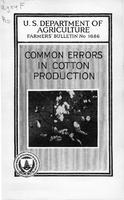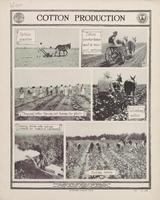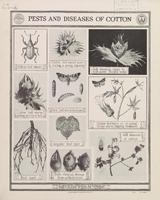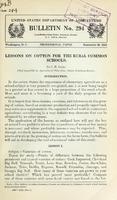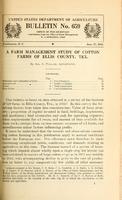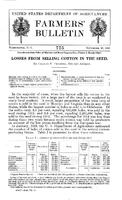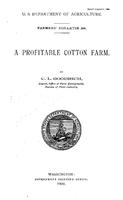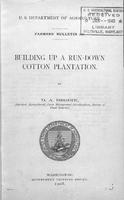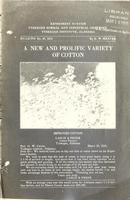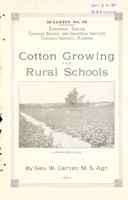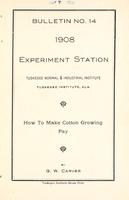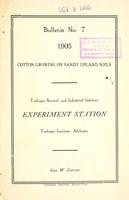Browse Items: 17
Page 1 of 1
Demonstration Work in Cooperation with Southern Farmers
The Farmers' Cooperative Demonstration Work conducted by the United States Department of Agriculture through the Bureau of Plant Industry was inaugurated under authority of Congress in January, 1904, primarily because of the depredations of the Mexican cotton boll weevil in the State of Texas. By the rapid spread of this pest east and north it had…
Building Up a Run-Down Cotton Plantation
This bulletin is an account of the progress made in three years in changing a run-down cotton plantation into a profitable stock and hay farm. The results obtained from the use of cowpeas and other leguminous crops in restoring the fertility of the land have exceeded the expectations of those in charge of the work. Not only have the crops yielded…
The Cotton-and-Tobacco South
Some of the Nation's richest land, and some of its poorest, lies in the 13 cotton - and - tobacco States: 28 percent of the country's area, a region rich in natural resources, advantages of climate, population, and potentialities.
Industry is growing in the South, but the region still is predominantly agricultural. In addition to cotton,…
Industry is growing in the South, but the region still is predominantly agricultural. In addition to cotton,…
Facts About Cotton
COTTON is the great crop of the South. It is grown on about 2 million farms in the southern part of our country. The average size of the crop is about 13 million bales of cotton lint, each weighing about 500 pounds, and about 6 million tons of cottonseed.
Large quantities of cotton are grown in other countries, too — chiefly India, China, Egypt,…
Large quantities of cotton are grown in other countries, too — chiefly India, China, Egypt,…
Common Errors in Cotton Production
IMPROVEMENT of cotton production in the United States depends largely upon getting rid of numerous errors in production practice which are widely current and commonly overlooked, even among well-informed people.
General disregard of quality in cotton buying, effects of mixing and changing seed, of planting inferior varieties, and of carelessness…
General disregard of quality in cotton buying, effects of mixing and changing seed, of planting inferior varieties, and of carelessness…
Lessons on Cotton for the Rural Common Schools
In the cotton States the importance of elementary agriculture as a school subject is very generally recognized, and it is now being taught to a greater or less extent in a large proportion of the rural schools. More and more it is becoming a part of the daily program of the schools.
It is hoped that these lessons, exercises, and references on…
It is hoped that these lessons, exercises, and references on…
A Farm Management Study of Cotton Farms of Ellis County, Tex.
This bulletin is based on data obtained in a survey of the business of 120 farms in Ellis County, Tex., in 1914. In this survey the following factors were taken into consideration: Value of farm property; proportion of capital invested in land, buildings, implements, and machinery; feed inventories and cash for operating expenses; labor…
Losses From Selling Cotton in the Seed
In the majority of cases, when the farmer sells his cotton in the seed he loses his money, yet a large part of the crop is so marketed in many local markets. A much larger proportion of the total crop of cotton is sold in the seed in Missouri and Virginia than in any other States, while the largest number of bales so sold is in Oklahoma. Of the…
A Profitable Cotton Farm
This bulletin is an account of the progressive and successful farm operations of a farmer of South Carolina who, by combining thorough tillage, crop rotation, barnyard manure, and a judicious use of commercial fertilizer, has changed a previously badly managed and run-down cotton farm into a very productive and profitable enterprise. The impulse…
Building Up a Run-Down Cotton Plantation
This bulletin is an account of the progress made in three years in changing a run-down cotton plantation into a profitable stock and hay farm. The results obtained from the use of cowpeas and other leguminous crops in restoring the fertility of the land have exceeded the expectations of those in charge of the work. Not only have the crops yielded…
A New and Prolific Variety of Cotton
Sixteen years ago the Experiment Station undertook the production of a type of cotton that would possess the following characteristics:
1. A longer and finer staple.
2. A more prolific variety.
3. A disease resistant variety.
4. A cotton that produces well on light, sandy soils.
5. An early maturing variety that would escape…
1. A longer and finer staple.
2. A more prolific variety.
3. A disease resistant variety.
4. A cotton that produces well on light, sandy soils.
5. An early maturing variety that would escape…
Cotton Growing for Rural Schools
There is doubtless no plant more interesting to the casual observer, or more useful economically and more wonderful to the searcher for truth than the cotton plant. It forms the principal products of eight great states of this Union. It also has an ancient history. It is said to have been grown and manufactured into clothing over 2,500 years ago.…
How to Make Cotton Growing Pay
Two years of cotton experimentation have come and gone since the issue of Bulletin 7 of this station, on Cotton Growing on Sandy Upland Soils; in that bulletin we took the position that every acre in Alabama capable of growing cotton , could and should be made to produce a bale of cotton to the acre.
The bulletin further shows that the above…
The bulletin further shows that the above…
Cotton Growing on Sandy Upland Soils
This bulletin, in some degree is a continuation of No.6, on Soil Building, and emphasizes rather emphatically the possibilities of such soils in the production of cotton.
We have maintained that every acre of land in Alabama capable of being grown in cotton, could and should be made to produce at least one bale to the acre. The experiment…
We have maintained that every acre of land in Alabama capable of being grown in cotton, could and should be made to produce at least one bale to the acre. The experiment…
Fertilizer Experiments on Cotton
The cotton fertilizer experiments made in 1898 are a continuation of a series of fertilizer soil tests commenced in 1897. The soil of the experimental field, a part of the station farm, is a light and sandy upland, with yellow clay subsoil.
The soil selected is excellently adapted for experimental purposes, having formed part of an old field…
The soil selected is excellently adapted for experimental purposes, having formed part of an old field…
Page 1 of 1
 An official website of the United States government.
An official website of the United States government.


